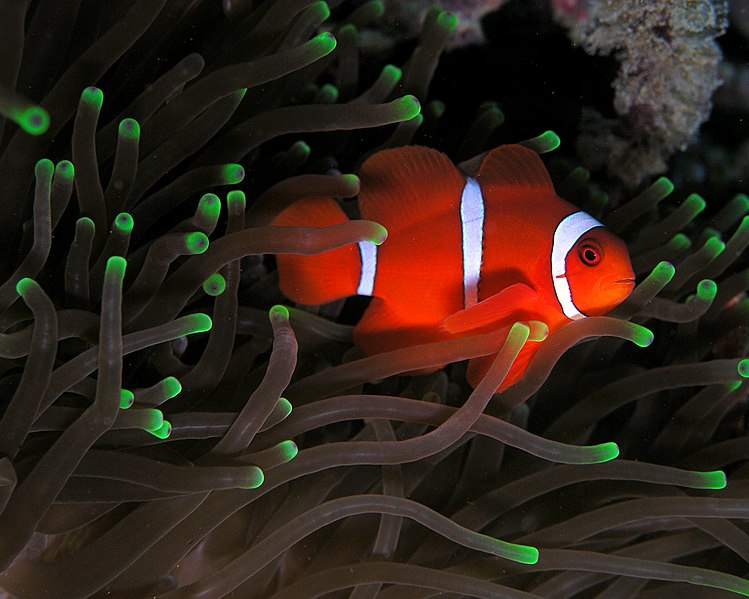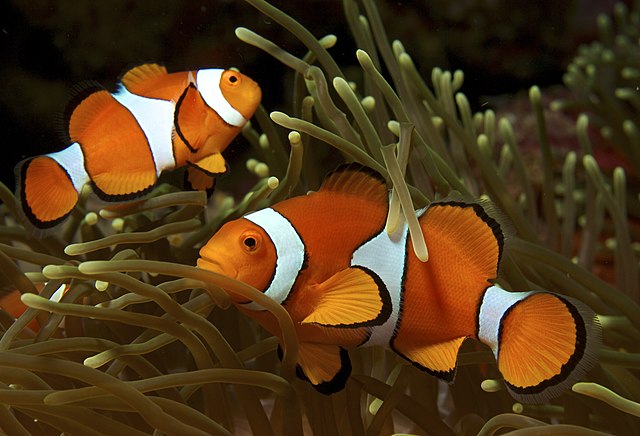- There are approximately 30 species of clownfish with many other variants from the captive breeders like the Maroon Lightning Clownfish:

2. They reach a maximum size of a little over 3 inches in length and have been reported to be up to 4 inches in length
3. They are primarily found in the shallow reefs of the Pacific and Indian Oceans
4. The Clownfish have a very unique and interesting symbiotic relationship with the sea anemone. The Clownfish over time have developed an immunity to the anemone’s poison. This allows the Clownfish to live on and in the anemone which provides the clownfish with protection from predators. The Clownfish provides food scraps to the anemone to as well as helps to lure in prey fish for the anemone to eat. In addition, the Clownfish provides the anemone with fertilizer from it’s waste.

5. There are ~10 species of anemones that will host a clownfish. Depending on the specific specie of clownfish will determine the type of anemone that is more or less compatible. For example, the Bubble Tip Anemone is most compatible with the Clark’s Clownfish, Tomato Clownfish, Red and Black Clownfish, Ocellaris Clownfish, Percula Clownfish and Maroon Clownfish. While the Magnificent Anemone is most compatible with the Skunk Clownfish, Clark’s Clownfish, Red and Black Clownfish, Ocellaris Clownfish, Percula Clownfish and the Pink Skunk Clownfish.
6. The clownfish – like all other anemonefish – are hermaphrodites. All clownfish fry hatch out of their eggs as male. The dominant male of the group will eventually grow larger and turn into a female. Often 2 males will pair up to mate until the dominant one turns into a female. If the female passes away for any reason, a new dominant male will turn into a female and take her place.
7. A study conducted in 2012 by University of Liège, Belgium discovered that the Clownfish communicate by making popping and clicking noises which help them maintain their rank and file among their group.
8. As omnivores, the clownfish diet consists of meat and plants including algae, zooplankton, worms and small crustaceans.
9. Clownfish – like all anemonefish – are monogamous. So once their pair off, they mate for life. Once a pair is established and the female’s transformation is complete, the male will chase her off to a nesting area. From there the female will deposit anywhere for 100 to 1,000 eggs onto the surface of a rock or other suitable structure. The male will then pass over the nest of eggs and release sperm in order to fertilize them. The male then attends to the nest for the next week or so until the eggs hatch.
10. According to National Geographic, since the original movie “Finding Nemo” aired, Clownfish sales have tripled. Overfishing occurred as the demand skyrocketed. Since the movie only glorified the species without providing any care tips or any information at all on what is required in order to have a Clownfish thrive in human care – according to the Aquarium Welfare Association (AWA) many people purchased this species without the proper knowledge on how to care for them. Inspired by a line in the movie, hundreds of children flushed their clownfish down the toilet in the hope of setting them free. And thus the “Finding Nemo Effect” was dubbed and a captive breeding effort on behalf of the aquarium industry was born in order to supply the demand and stop the collection of wild Clownfish. Pixar nor any of the actors were involved in any of the recovery of the species and Disney/Pixar even sold an extremely unsuitable fish tank for any species let alone a Clownfish with none of the profits going back to the conservation of the species.
Thanks to the aquarium industry this species is not endangered and their wild numbers are doing very well.
